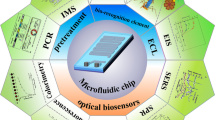Abstract
A series piezoelectric quartz crystal (SPQC) sensor was developed for quantitative determination of Lactobacillus spp. populations in milk. When the electrodes were immersed in a reaction cell with bacterial inoculum, the change of frequency was caused by the impedance change of the microbial metabolism. A significant frequency decrease was found due to the coagulation of milk when the Lactobacillus spp. was cultivated in the media. The SPQC sensor system established in this study demonstrated the specificity and selectivity for detection of Lactobacillus spp. in milk sample. The calibration curve of detection time against density of Lactobacillus spp. shows a linear correlation coefficient (R 2 = 0.8453) over the range of 102–2.4 × 105 CFU ml−1. The detection time was influenced by the addition of peptone and glucose. The sensor exhibited rapid (within 4 h) and enabled real time monitoring of Lactobacillus spp. growth. This system is potentially applicable to detect Lactobacillus spp. concentration at local farm when a suitable temperature control device is adapted.






Similar content being viewed by others
References
Fuller R (1989) J Appl Bacteriol 66:365–378
Vinderola C, Reinheimer J (1999) Int Dairy J 9:497–505
Verluyten J, Messens W, Vuyst L (2003) Appl Environ Microbiol 69:3833–3839
Klaver F, Kingma F, Weerkamp A (1993) Neth Milk Dairy J 47:151–164
Dave R, Shah N (1997) Int Dairy J 7:31–41
Ravula R, Shah N (1998) Aust J Dairy Tech 53:175–179
Lourens-Hattingh A, Viljoen B (2001) Int Dairy J 11:1–17
Talwalkar A, Kailasapathy K (2004) Int Dairy J 14:143–149
Hamilton-Miller J, Shah S, Winkler J (1999) Public Health Nutr 2:223–229
Charteris W, Kelly P, Morelli L, Collins J (1997) Int J Food Microbiol 35:1–27
Leoni E, Legnani P (2001) J Appl Microbiol 90:27–33
Bej A, Mahbubani M, Dicesare J, Atlas R (1991) Appl Environ Microbiol 57:3529–3534
Dubernet S, Desmasures N, Gueguen M (2002) FEMS Microbiol Lett 214:271–275
Yuki N, Watanabe K, Mike A, Tagami Y, Tanaka R, Ohwaki M, Morotomi M (1999) Int J Food Microbiol 48:51–57
Durant J, Young C, Nisbet D, Stanker L, Ricke S (1997) Int J Food Microbiol 38:181–189
Moon B, Kim Y (2003) Bull Korean Chem Soc 24:1203–1206
Kang D, Siragusa G (1999) Appl Environ Microbiol 65:5334–5337
Lehoux D, Sanschagrin F, Levesgue R (2002) FEMS Microbiol Lett 210:73–80
Levi K, Smedley J, Towner K (2003) Clin Microbiol Infect 9:754–758
Kao Y, Liu Y, Shyu Y (2007) Food Res Int 40:71–79
Ricke S, Schaefer D, Cook M, Kang K (1988) Appl Environ Microbiol 54:596–599
Felice C, Madrid R, Olivera J, Rotger V, Valentinuzzi M (1999) J Microbiol Meth 35:37–42
Chang K, Jang H, Lee C, Lee Y, Yuan C, Lee S (2006) Biosens Bioelectron 21:1581–1590
Aaku E, Collison E, Gashe B, Mpuchane S (2004) Food Control 15:181–186
Abdul-Raouf U, Beuchat L, Ammar M (1993) Appl Environ Microbiol 59:2364–2368
van Netten P, Mossel D, Huis In t Veld J (1995) Int J Food Microbiol 25:1–9
Ogawa M, Shimizu K, Nomoto K, Tanaka R, Hamabata T, Yamasaki S, Takeda T, Takeda Y (2001) Int J Food Microbiol 68:135–140
Acknowledgments
The authors would like to thank the National Science Council of the Republic of China (Taiwan) for financially supporting this research under Contract No. NSC96-2113-M-264-001-MY2.
Author information
Authors and Affiliations
Corresponding authors
Rights and permissions
About this article
Cite this article
Jang, HD., Chang, KS., Lee, YG. et al. Quantitative determination of Lactobacillus spp. in milk using a series piezoelectric quartz crystal sensor. Eur Food Res Technol 229, 349–355 (2009). https://doi.org/10.1007/s00217-009-1047-7
Received:
Revised:
Accepted:
Published:
Issue Date:
DOI: https://doi.org/10.1007/s00217-009-1047-7




